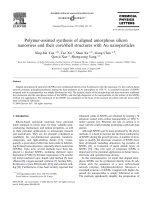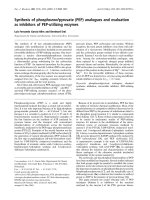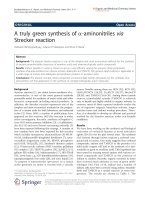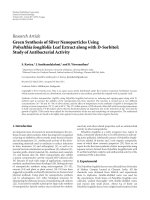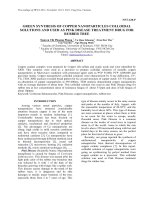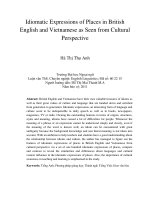Green synthesis of copper nanoparticles colloidal solutions and used as pink disease treatment drug for rubber tree
Bạn đang xem bản rút gọn của tài liệu. Xem và tải ngay bản đầy đủ của tài liệu tại đây (1.55 MB, 4 trang )
Proceedings of IWNA 2011, November 10-12, 2011, Vung Tau, Vietnam .
NFT-228-P
GREEN SYNTHESIS OF COPPER NANOPARTICLES COLLOIDAL
SOLUTIONS AND USED AS PINK DISEASE TREATMENT DRUG FOR
RUBBER TREE
Nguyen Thi Phuong Phong
1
, Vo Quoc Khuong
1
,Tran Duc Tho
2
Cao Van Du
3
, Ngo Hoang Minh
3
1
Faculty of Chemistry, University of Sciences, VNU HCM City
2
Faculty of Chemistry, University of Technology, VNU HCM City
3
Faculty of Chemistry, Lac Hong University, Bien Hoa City
Email:
ABSTRACT
Copper oxalate complex were prepared by Copper (II) sulfate and oxalic acide and were identified by
XRD. This complex were used as a precusor to prepare colloidal solutions of metallic copper
nanoparticles in Microwave condition with protectant agent such as PVP 55,000, PVP 1,000,000 and
glycerine media. Copper nanoparticles colloidal solutions were characterized by X-ray diffraction, UV-
Vis, TEM. XRD analysis revealed broad pattern for fcc crystal structure of copper metal. UV-Vis showed
an absorption of copper nanoparticles at 595-600nm. TEM analysis demontrated copper nanoparticles
with an average diameter of about 6nm. This colloidal solution was used as anti Pink Disease drug for
rubber tree at low concentration (dose of resistance fungus of about 5-7ppm and dose of kill fungus of
about 10ppm).
Keyword: Corticium Salmonocolor, Pink Disease, copper nanoparticles, rubber tree
INTRODUCTION
Among various metal particles, copper
nanoparticles have attracted considerable
attention because copper is one of the most
important metals in modern technology [1].
Considerable interest has been focused on
copper nanoparticles due to their optical,
catalytic, mechanical and electrical properties
[2]. The advantages of Cu nanoparticles are
cheap, high yields in mild reaction conditions
and have short reaction times compared to
traditional catalysts [3]. Cu nanoparticles have
been synthesized through different methods such
as thermal decomposition [2], metal salt
reduction [3] microwave heating [6], radiation
methods [6], micro emulsion techniques [6], …
Pink Disease (Scientific Name: Macrophoma
mangiferae) is caused by fungus of Corticium
Salmonocolor. This disease was named after the
light pink color of the rubber tree branches that
was infected by it with 1 of the bark of the
branches growing with fungis like a spider web.
This disease causes damage to the trunk of the
rubber trees, it is dangerous and be able
damages to mainly major branches of the tree;
especially those from 2 to 7 years of age. This
type of disease mainly occers in the rainy season
and peaks at the months of July, August, with
the reasonable temperature of 20-30
0
C, and the
humidity level above 80%. This type of disease
are more common at places where there is little
to no room for the water to escape, usually
floooded areas. Pink Disease is a common
disease on the trunks of wood trees in tropical
areas in of the world. Areas in which the rain
level is above 250 mm/month along with hot and
humid days in the rainy season, are the perfect
place for this kind of disease to grow.
Recently, our group reported the synthesis of
uniformsized nanoparticles of copper
nanoparticles from thermal decomposition of
copper oxalate complexes [7]. In this report,
colloidal solution of copper nanoparticles were
going on synthesizing by polyol method from
copper oxalate as a precursor. This colloidal
solution was used as Pink Disease treatment
drugs for rubber tree.
Proceedings of IWNA 2011, November 10-12, 2011, Vung Tau, Vietnam .
EXPERIMENTAL
Materials
• Copper Sulfate CuSO
4
.5H
2
O (Merck,
99%)
• Acid oxalic (Merck, 99%)
• Milipore Water (Merck, 99%)
• Polyvinyl pyrolidone (PVP, Mw ≈
1,000,000 BASF-Germany, 99%)
• Glycerine (99%, AR-China)
All the chemicals reagents used in our
experiments were used as received without
further purification.
Synthesis of copper oxalate
Copper oxalate precursor was synthesized
according to this procedure: the CuSO
4
.5H
2
O (2
mmol) was dissolved into 50 ml of DI water
(Merck) to form a homogeneous solution. A
stoichiometric amount of acid oxalic dissolved
in an equal volume of DI water and was
dropwise added into the above solution under
magnetic stirring. The solution was stirred for
about 15 min and a blue precipitate was
centrifuged and washed by water to pH=7 and
by ethanol several times. The product was dried
at 50
0
C. The copper oxalate, CuC
2
O
4
, was
characterized by FE-SEM, powder X-ray
diffraction (XRD).
Synthesis of Cu nanoparticles
Poly(N-vinylpyrrolidone) acting as a capping
agent, was dissolved in glycerine and heated
with stirring in an oil bath at temperature
reaction (180-200
0
C). Copper Oxalate was then
added into the hot reaction medium and was
heated until the color of this solution changes to
cloudy orange.
Characterization
UV-Vis absortion were received by UV-Vis
(NIR-V670-Jacco Japan, UNS-VNU). XRD
patterns were recorded by a D8 Advance, Bruker
- Germany (Institute of Applied Materials
Science-VAST).Field Emission Scanning
electron microscopy (FE-SEM) images were
obtained on S4800 – Hitachi, SHTP Park, HCM
city. Transmission electron microscopy (TEM)
images were obtained on a JEM-1400, Japan
,UT-VNU.
Microbiological tests
Corticium Salmonocolor were supplied by
Faculty of Biology, University of Natural
Sciences, VNU-HCMC. Antifungal effects of the
Cu colloidal solutions were studied by culture
medium toxicity method in PGA media (Petri
Dish).
RESULTS AND DISCUSSION
Precusor of copper oxalate
Copper oxalate was prepared with high yield
and confirmed by powder XRD (Fig.1). The
interplanar d-spacings of the corresponding lines
presented in the powder XRD pattern match
those of standard sample, which corresponded to
the primitive monoclinic system. Moreover, it
was clear from XRD that no other phases of
copper oxalate was presented in the as-
synthesized copper oxalate. The FE-SEM image
of copper oxalate showed particles in the size
range of under 150 nm (Fig. 2).
Fig. 1. XRD pattern of copper oxalate.
Fig. 2. The FE-SEM image of copper oxalate
Proceedings of IWNA 2011, November 10-12, 2011, Vung Tau, Vietnam .
d= 6,39 ± 1,51
Synthesis of copper colloidal solutions
Table 1. Copper colloidal solutions
Sample
Glycerin
(ml)
CuC
2
O
4
(g)
PVP 55000
(g)
CuC
2
O
4
: PVP
Temp.
(
0
C)
Wave lenghth
(UV-Vis)
1
60
0,01
0,20
1 : 20
240
586
2
60
0,01
0,15
1 : 15
240
590
3
60
0,01
0,10
1 : 10
240
587
4
60
0,01
0,05
1 : 5
240
597
5
60
0,01
0,01
1 : 1
240
598
6
60
0,05
0,01
5 : 1
240
589
7
60
0,10
0,01
10 : 1
240
591
8
60
0,15
0,01
15 : 1
240
591
9
60
0,20
0,01
20 : 1
240
594
The results from UV-Vis of the samples was
illustrated in the Fig. 3. Nanosized particles
exhibit unique optical properties with an
exponential-decay Mie scattering profile with
decreasing photon energy. In this reports, all of
experiments from 1 to 9 show an absorption
peaks of copper nanoparticles at from 586 to
594nm. The synthesized copper colloidal
solutions were stable for over 2 months,
especially the 5
th
samples stable for over 3
months. The stabilization of copper colloidal
solutions were due to the capping of
nanoparticles by PVP 55,000 in reaction
process. The 5
th
sample were testing to
treatment Pink disease for Rubber Tree.
Fig. 3. UV-vis Absorbance spectra of the copper
colloidal solutions
Characteristics of CuNPs
Copper colloidal solutions were coating on
the glass of microscopy by spin coating and
baked at 300
0
C. The X-ray diffraction patterns
which were corresponded to crystalline copper
characteristic peaks with a face-centered-cubic
(fcc) crystal structure at 2θ value of 43,60 ,
50,70 and 74,50 representing (111), (200) and
(220) planes of fcc structure of copper (Fig. 4).
Fig. 4. X-ray diffraction patterns of CuNPs-
PVP
Characterized by TEM
The TEM image of the 5
th
sample showed
that the average size of copper nanoparticles was
about 6nm.
Fig. 5. TEM image and histogram of copper
nanoparticle size ditribution in 5
th
sample.
Proceedings of IWNA 2011, November 10-12, 2011, Vung Tau, Vietnam .
Microbiological tests
Corticium Salmonocolor were supplied by
Faculty of Biology, University of Natural
Sciences, VNU-HCMC. Antifungal effects of
the Cu colloidal solutions were studied by
culture medium toxicity method in PAG media
(Petri Dish) and spraying method. This colloidal
solution was used as anti Pink Disease drug for
rubber tree at low concentration (dose of
resistance fungus of about 5-7ppm (Fig.6) and
dose of kill fungus of about 10ppm (Fig.7).
Fig. 6. Anti-Corticium Salmonicolor Testing
(Corticium Salmonicolor was found at Control
Sample (ĐC) after 7 days and wasn’t found at
nano copper solution samples with
concentration of 5-7ppm after 15 days
Fig. 7. Kill-Corticium Salmonicolor Testing
(Corticium Salmonicolor was found at Control
Sample (ĐC) after 15 days and wasn’t found at
nanocopper solution samples with
concentration of 10-20ppm after the first
spraying (after15 days)
CONCLUSIONS
Copper colloidial solutions had been
synthesized rapidly in chemical green condition,
without reagent. The UV-Vis spectra showed
that these as-synthesis samples had absorbance
peak from 588 to 598nm. The average size of
copper nanoparticles was about 6nm via TEM
images.
This colloidal solution was used as anti Pink
Disease drug for rubber tree at low
concentration (dose of resistance fungus of
about 5-7ppm and dose of kill fungus of about
10ppm).
References
[1] S. Giuffrida, L.L. Costanzo, Nanopart Res
(2008) 10: 1183-1192
[2] M. H.Kim, B. Lim, E.P. Lee, Y. Xia, Journal
of Materials Chemistry, 2008, 18, 4069-4073
[3] M.Satlavati-Niasari, F.Davar, N. Mir,
Polyhedron 27 (2008) 3514-1518
[4] S.T. Gold, R.W.Bruce, A.W.Fliflet, Review
of scientific instruments, 78, 023901 (2007)
[5] B.K. Park, S. Jeong, D. Kim, J. Moon, S.
Lim, S. Kim, Journal of Colloid and Interface
Science 311(2007) 417-424
[6] N.T.P. Phong, N.H. Minh, et al., Journal of
Physics: Conference Series 187 (2009) 012078
[7] N.T.P.Phong, P.N.Khuyen, N.V.K. Thanh,
Processding of SPMS 2009, Danang, 8-
10/11/2009
